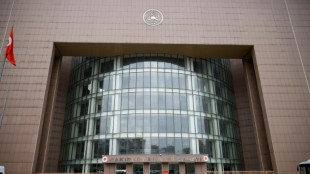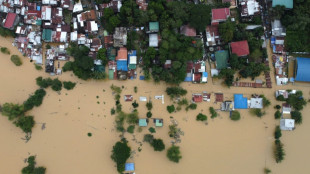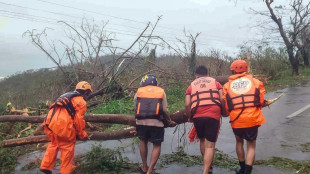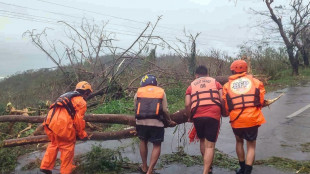
-
 Spanish resort to ban new holiday flats in 43 neighbourhoods
Spanish resort to ban new holiday flats in 43 neighbourhoods
-
Hong Kong to sentence dozens of democracy campaigners

-
 Russian extradited to US from SKorea to face ransomware charges
Russian extradited to US from SKorea to face ransomware charges
-
Phone documentary details Afghan women's struggle under Taliban govt

-
 G20 wrestles with wars, 'turbulence' in run-up to Trump
G20 wrestles with wars, 'turbulence' in run-up to Trump
-
Kane hoping to extend England career beyond 2026 World Cup

-
 Gazans rebuild homes from rubble in preparation for winter
Gazans rebuild homes from rubble in preparation for winter
-
'Vague' net zero rules threaten climate targets, scientists warn

-
 Stocks, dollar hesitant as traders eye US rate outlook, Nvidia
Stocks, dollar hesitant as traders eye US rate outlook, Nvidia
-
G20 wrestles with wars, climate in run-up to Trump

-
 'Agriculture is dying': French farmers protest EU-Mercosur deal
'Agriculture is dying': French farmers protest EU-Mercosur deal
-
Beyonce to headline halftime during NFL Christmas game

-
 Rescuers struggle to reach dozens missing after north Gaza strike
Rescuers struggle to reach dozens missing after north Gaza strike
-
Russia vetoes Sudan ceasefire resolution at UN

-
 G20 host Brazil launches alliance to end 'scourge' of hunger
G20 host Brazil launches alliance to end 'scourge' of hunger
-
Stocks, dollar hesitant as traders scale back US rate cut bets

-
 Trump confirms plan to use military for mass deportation
Trump confirms plan to use military for mass deportation
-
Schools closed in Beirut after deadly Israeli air raid

-
 Anger, pain in Turkey as 'newborn deaths gang' trial opens
Anger, pain in Turkey as 'newborn deaths gang' trial opens
-
Kremlin says Biden 'fuelling' war as Russian strikes rock Odesa

-
 UN climate chief at deadlocked COP29: 'Cut the theatrics'
UN climate chief at deadlocked COP29: 'Cut the theatrics'
-
G20 leaders gather to discuss wars, climate, Trump comeback

-
 Stocks, dollar mixed as traders scale back US rate cut bets
Stocks, dollar mixed as traders scale back US rate cut bets
-
Stoinis lets rip as Australia crush Pakistan for T20 series whitewash

-
 Bentancur banned for seven games over alleged racial slur
Bentancur banned for seven games over alleged racial slur
-
Kremlin says Biden 'fuelling' tensions with Kyiv missile decision

-
 COP host Azerbaijan jailed activists over 'critical opinions': rights body
COP host Azerbaijan jailed activists over 'critical opinions': rights body
-
Composer of Piaf's 'Non, je ne regrette rien' dies aged 95

-
 South African trio nominated for World Rugby player of year
South African trio nominated for World Rugby player of year
-
'Not here for retiring': Nadal insists focus on Davis Cup

-
 Tractor-driving French farmers protest EU-Mercosur deal
Tractor-driving French farmers protest EU-Mercosur deal
-
Floods hit northern Philippines after typhoon forces dam release

-
 Pakistan skittled for 117 in final T20 against Australia
Pakistan skittled for 117 in final T20 against Australia
-
Schools closed in Beirut after deadly Israeli strike

-
 Chris Wood hits hat-trick in NZ World Cup qualifying rout
Chris Wood hits hat-trick in NZ World Cup qualifying rout
-
Markets mixed after Wall St losses as traders weigh US rates outlook

-
 US, Philippines sign deal on sharing military information
US, Philippines sign deal on sharing military information
-
Bangladeshi ex-ministers face 'massacre' charges in court

-
 Law and disorder as Thai police station comes under monkey attack
Law and disorder as Thai police station comes under monkey attack
-
Disgraced Singapore oil tycoon sentenced to nearly 18 years for fraud

-
 Philippines cleans up as typhoon death toll rises
Philippines cleans up as typhoon death toll rises
-
Quincy Jones awarded posthumous Oscar

-
 'Critically endangered' African penguins just want peace and food
'Critically endangered' African penguins just want peace and food
-
Long delayed Ukrainian survival video game sequel set for release amid war

-
 Star Australian broadcaster charged with sex offences
Star Australian broadcaster charged with sex offences
-
Philippines cleans up after sixth major storm in weeks

-
 Woman-owned cafe in Indonesia's Sharia stronghold shakes stigma
Woman-owned cafe in Indonesia's Sharia stronghold shakes stigma
-
Indigenous Australian lawmaker who heckled King Charles censured

-
 End of an era as Nadal aims for winning Davis Cup farewell
End of an era as Nadal aims for winning Davis Cup farewell
-
Trump taps big tech critic Carr to lead US communications agency


Frozen in time: Colombian town's unexplained mummies
In a small town high in the Colombian Andes, Clovisnerys Bejarano kneels before a glass box holding the petrified corpse of her mother, who died 30 years ago, but looks as if she might just be asleep.
Saturnina Torres de Bejarano is dressed in the same rose-print dress and green woolen jersey she was interred in, clasping a fake red carnation in her eerily well-preserved hands.
"She still has her little brown face, round, her braids, her hair," Bejarano, 63, told AFP at her mother's final resting place in a museum displaying her body and those of 13 others from the town of San Bernardo who became spontaneously, and mysteriously, mummified after death.
"If God wanted to preserve her... it must be for a reason," said Bejarano, a resident of the town some 100 kilometers (62 miles) south of Bogota.
Torres was interred in a vault in the San Bernardo municipal cemetery in 1993.
Exhumed in 2001 -- as is customary to make space for new bodies -- her relatives found her still with hair, nails and much of her tissue unspoilt.
It came as no major surprise. Dozens of mummified bodies have come out of the vaults since the first one in 1963.
"When all this began, people were a little incredulous about what was happening; they thought these were going to be isolated events," said museum guide Rocio Vergara.
"As time went on, it became more and more frequent to find bodies in this condition," she told AFP.
Some even still had their eyes, usually quick to decompose.
In the late 1980s, some 50 mummies were found in the mausoleum every year, but the rate has declined to a handful per year, said Vergara.
- Reward after death? -
Despite numberous attempts by experts to explain the phenomenon -- which has also been observed in countries such as Mexico and Italy -- the reason for the spontaneous mummification in San Bernardo has never been pinned down, said Vergara.
Some locals "believe "that the process (mummification) is due to the fact that the person was too good, and it is a reward after death," said Vergara.
"There are others who consider that... it is a punishment."
Most are convinced it is because of the healthy diet of the residents of temperate San Bernardo, and an active, farming lifestyle.
But this is not always borne out by the evidence: one of the mummies belongs to Jorge Armando Cruz, who spent most of his life in the big city of Bogota, where he died before being brought back to his birthplace for burial.
There is no clear pattern to the mummifications: those who are involved are of all different ages when they died, and no particular gender or body type predominates.
Vergara said there is no particular sector of the cemetery that yields more mummies than others.
- 'Like an oven' -
Many believe the answer must lie in the burial vaults.
The first mummies were found in San Bernardo only after the cemetery, which has no underground graves, was inaugurated.
Prior to the 1960s, the town had two burial grounds with not a single known case of mummification, said Vergara.
The climate in the area is humid, which would ordinarily aid decomposition, not hinder it, she added.
Anthropologist Daniela Betancourt of the National University of Colombia said the phenomenon could be due to the cemetery's placement on a steep mountain slope.
"The wind is constantly blowing as it is hot. It is possible to assume that the vaults work like an oven... they dehydrate you."
This hypothesis still needs to be tested, Betancourt told AFP.
"There has been a lack (of) studies about what is happening and what specific conditions are the ones that cause people to mummify," she said.
Relatives of the mummified corpses must authorize their display in the museum.
Most opt to have the remains cremated instead, but the Bejarano family did not wish that fate for Torres.
"God wanted to leave her to us, and here we have her... Seeing her like that, how could one let her be cremated," asked Bejarano, who regularly brings Torres's great-grandchildren to visit her tomb.
/lv/das/mar/mlr/mdl
E.Hall--AT




